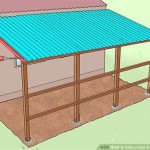How To Clean Oil Stains From Concrete Garage Floor
Oil stains on a concrete garage floor are an unsightly and common problem for many homeowners. These stains can be difficult to remove due to the porous nature of concrete, which allows oil to penetrate deep into the surface. Ignoring these stains can lead to further degradation of the concrete, creating an unsafe and unattractive environment. This article provides a comprehensive guide on effectively removing oil stains from concrete garage floors, focusing on various methods and preventative measures.
Understanding the Nature of Oil Stains on Concrete
Concrete is a composite material consisting of cement, aggregates, and water. Its porous structure allows liquids like oil, grease, and other automotive fluids to easily seep into the surface. Once absorbed, the oil becomes trapped within the concrete's pores, making simple surface cleaning ineffective. The longer the oil remains on the concrete, the deeper it penetrates and the more difficult it becomes to remove. Furthermore, the type of oil and the age of the stain influence the cleaning approach required. Fresh spills are generally easier to treat than older, deeply embedded stains. Identifying the type of oil (e.g., motor oil, transmission fluid, brake fluid) can also help in selecting the most appropriate cleaning agent. Effective stain removal requires breaking down the oil molecules and extracting them from the concrete pores.
The composition of the concrete itself also plays a role. Concrete with a higher porosity will absorb oil more readily, requiring more aggressive cleaning methods. Furthermore, the presence of sealants or coatings can affect how oil interacts with the surface. Some sealants offer a degree of protection against oil penetration, while others may be damaged by certain cleaning agents. It's crucial to consider the type of sealant, if any, before proceeding with any cleaning method.
Environmental factors also contribute to the complexity of removing oil stains. Temperature, humidity, and exposure to sunlight can all affect the rate at which oil penetrates and reacts with the concrete. Warmer temperatures tend to accelerate the absorption process, while prolonged exposure to sunlight can cause the oil to oxidize and become even more difficult to remove. The presence of dirt and debris on the concrete surface can also compound the problem by trapping the oil and preventing effective cleaning.
Methods for Removing Oil Stains from Concrete
Several methods can be employed to remove oil stains from concrete garage floors, ranging from simple household remedies to specialized cleaning products. The choice of method depends on the severity and age of the stain, as well as the availability of resources. It's always recommended to test any cleaning solution in an inconspicuous area first to ensure it doesn't damage or discolor the concrete.
1. Absorbent Materials: For fresh spills, immediately applying an absorbent material is often the most effective first step. This helps to prevent the oil from penetrating deeper into the concrete. Common absorbent materials include:
- Cat Litter: A readily available and inexpensive option. Spread a thick layer of cat litter over the stain and allow it to sit for several hours, or preferably overnight. The litter will absorb the oil. Sweep up the litter and dispose of it properly.
- Sawdust: Similar to cat litter, sawdust can effectively absorb fresh oil spills. It is particularly useful for larger spills due to its availability in bulk.
- Cornstarch or Baking Soda: These finer powders can be used for smaller spills or as a follow-up treatment after using cat litter or sawdust. They are effective at drawing out residual oil from the concrete pores.
- Commercial Absorbent Pads: Designed specifically for oil spills, these pads offer superior absorption capabilities and can be found at automotive supply stores.
After applying the absorbent material, it's crucial to thoroughly sweep or vacuum up the residue. Avoid using water at this stage, as it can spread the oil further and drive it deeper into the concrete.
2. Detergents and Soaps: For older or more stubborn stains, detergents and soaps can be used to break down the oil and lift it from the concrete. Several options are available:
- Dish Soap: A common household item that can be effective for removing mild oil stains. Apply a generous amount of dish soap directly to the stain and scrub with a stiff-bristled brush. Let it sit for 15-20 minutes, then rinse thoroughly with water.
- Laundry Detergent: Similar to dish soap, laundry detergent can help to emulsify the oil and lift it from the concrete. Use a powdered detergent for better scrubbing action.
- Degreasers: Specifically formulated to remove grease and oil, degreasers are a stronger option for more stubborn stains. Follow the manufacturer's instructions carefully, as some degreasers can be harsh and may require protective gear.
- Concrete Cleaners: Designed specifically for cleaning concrete surfaces, these cleaners often contain enzymes or bacteria that break down oil and grease. They are generally safe for use on concrete and can be found at hardware stores.
When using detergents or soaps, it's important to scrub the stained area thoroughly with a stiff-bristled brush. A circular motion is often most effective. After scrubbing, rinse the area thoroughly with water to remove the detergent and any remaining oil. For stubborn stains, repeat the process multiple times.
3. Chemical Solutions: For the most stubborn and deeply embedded oil stains, more aggressive chemical solutions may be necessary. These solutions should be used with caution and proper safety precautions, including wearing gloves, eye protection, and a respirator if necessary.
- Trisodium Phosphate (TSP): A powerful cleaning agent that can effectively remove oil and grease. However, TSP is a corrosive substance and should be handled with care. Follow the manufacturer's instructions carefully and rinse thoroughly after use. TSP is also harmful to the environment and its use may be restricted in some areas.
- Muriatic Acid: A highly corrosive acid that can be used to etch the concrete surface and remove stains. Muriatic acid should be used as a last resort and only by experienced individuals. It can damage the concrete if not used properly and poses significant health risks. Always wear appropriate protective gear and ensure adequate ventilation.
- Commercial Concrete Stain Removers: Several commercial products are specifically designed to remove oil stains from concrete. These products often contain a blend of solvents, detergents, and enzymes that break down the oil and lift it from the concrete. Follow the manufacturer's instructions carefully.
When using chemical solutions, it's crucial to neutralize the area after cleaning. This can be done by rinsing the area with a solution of baking soda and water. This helps to prevent any residual chemicals from damaging the concrete or posing a safety hazard.
Preventative Measures to Minimize Oil Stains
Preventing oil stains in the first place is always the best approach. Implementing preventative measures can significantly reduce the likelihood of oil spills and make any spills that do occur easier to clean up. These measures include:
- Using Oil Drain Pans: When performing oil changes or other maintenance on vehicles, always use an oil drain pan to catch any spills. Ensure the pan is large enough to accommodate the entire volume of oil and that it is properly positioned to prevent drips.
- Placing Protective Mats: Placing protective mats or pads under vehicles can help to absorb any drips or leaks. These mats are typically made of absorbent materials that prevent oil from reaching the concrete surface.
- Promptly Cleaning Up Spills: As mentioned earlier, promptly cleaning up spills is crucial. The longer the oil remains on the concrete, the deeper it penetrates and the more difficult it becomes to remove. Keep absorbent materials readily available for immediate cleanup.
- Sealing the Concrete: Applying a concrete sealant can create a protective barrier that prevents oil from penetrating the surface. Several types of sealants are available, including acrylic, epoxy, and polyurethane sealants. Choose a sealant that is specifically designed for garage floors and resistant to oil and chemicals.
- Regular Cleaning: Regular cleaning of the garage floor can help to prevent oil and dirt from accumulating. Sweep or vacuum the floor regularly to remove loose debris. Periodically wash the floor with a mild detergent and water to remove any surface oil or grime.
By implementing these preventative measures, the occurrence of oil stains can be significantly reduced, maintaining a clean and well-maintained garage floor. Consistent preventative maintenance is far more effective and less labor-intensive than repeated attempts to remove deeply embedded stains. Furthermore, a clean and well-maintained garage floor not only enhances the aesthetic appeal of the home but also contributes to a safer and more functional workspace.
In conclusion, effectively cleaning oil stains from a concrete garage floor requires a multi-faceted approach that considers the nature of the stain, the properties of the concrete, and the available cleaning methods. While various techniques can be employed, preventative measures remain the most efficient and cost-effective strategy for maintaining a clean and stain-free garage floor. Understanding the principles outlined in this article will empower homeowners to tackle oil stains effectively and preserve the integrity of their concrete garage floors.

Tips To Remove Oil Stains On Your Garage Floor

How To Remove Oil Stains From Driveway In 5 Steps Prosoco

How To Remove An Oil Stain From Concrete

How To Remove Oil Stains From Concrete Floors Family Handyman

How To Clean Concrete Garage Floors From Oil Stains Rust

Removing Oil Stains In A Concrete Floor

How To Clean A Oil Stain Garage Floor

How To Remove Oil Stains From Concrete Floors Family Handyman

How To Remove Old Oil Stains From Garage Floor Flow Wall

Tips For Cleaning Your Concrete Garage Floor Richfield
Related Posts








